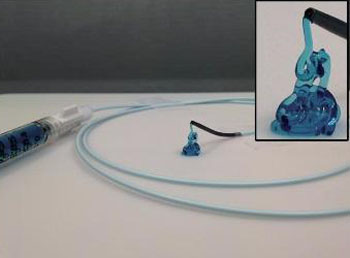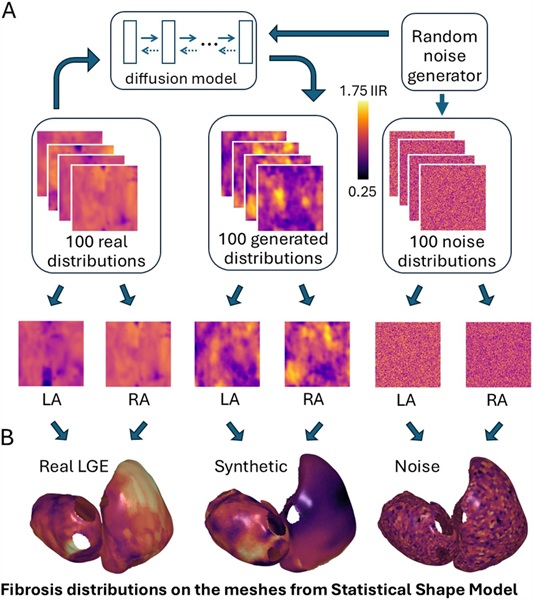Injectable Viscous Hydrogel Stops Uncontrolled Bleeding
|
By Daniel Beris Posted on 29 Nov 2016 |

Image: An injectable shear-thinning biomaterial aids endovascular embolization (Photo courtesy of Ali Khademhosseini/ HMS).
A new study describes a novel embolic agent for endovascular embolization procedures that has a hemostatic activity comparable to that of metallic coils, the current gold standard.
Developed by researchers at the Massachusetts Institute of Technology (MIT; Cambridge, MA, USA), Brigham and Women’s Hospital (Boston, MA, USA), Harvard Medical School (HMS; Boston, MA, USA), and other institutions, the shear-thinning biomaterial (STB) is made up of a nanocomposite hydrogel that also contains gelatin and silicate nanoplatelets.
The nanocomposite STBs are injected through clinical catheters and needles in a viscous, toothpaste-like consistency. Once in place, the biomaterial expands and hardens, fully occluding the vasculature. It subsequently remains at the site of injection (without fragmentation) until it undergoes natural degradation over time. Advantages include rapid delivery, in vivo stability, and independent occlusion that do not rely on intrinsic thrombosis. The study was published on November 16, 2016, in Science Translational Medicine.
“Current therapies that try to occlude blood vessels and stop bleeding in cases of internal bleeding do not work for a major segment of population that are on anticoagulant medication, or have disorders which prevents their blood from clotting,” said Professor Ali Khademhosseini, PhD, of HMS and Brigham and Women's Hospital. “Our material provides a solution to this issue, and allows for a new standard of care that replaces metallic coils, which are expensive and complicated to use.”
Endovascular embolization of damaged blood vessels can generate better patient outcomes and minimize the need for repeat procedures. However, many embolic materials, such as metallic coils or liquid agents, are associated with limitations and complications such as breakthrough bleeding, coil migration, coil compaction, recanalization, adhesion of the catheter to the embolic agent, or toxicity.
Related Links:
Massachusetts Institute of Technology
Brigham and Women’s Hospital
Harvard Medical School
Developed by researchers at the Massachusetts Institute of Technology (MIT; Cambridge, MA, USA), Brigham and Women’s Hospital (Boston, MA, USA), Harvard Medical School (HMS; Boston, MA, USA), and other institutions, the shear-thinning biomaterial (STB) is made up of a nanocomposite hydrogel that also contains gelatin and silicate nanoplatelets.
The nanocomposite STBs are injected through clinical catheters and needles in a viscous, toothpaste-like consistency. Once in place, the biomaterial expands and hardens, fully occluding the vasculature. It subsequently remains at the site of injection (without fragmentation) until it undergoes natural degradation over time. Advantages include rapid delivery, in vivo stability, and independent occlusion that do not rely on intrinsic thrombosis. The study was published on November 16, 2016, in Science Translational Medicine.
“Current therapies that try to occlude blood vessels and stop bleeding in cases of internal bleeding do not work for a major segment of population that are on anticoagulant medication, or have disorders which prevents their blood from clotting,” said Professor Ali Khademhosseini, PhD, of HMS and Brigham and Women's Hospital. “Our material provides a solution to this issue, and allows for a new standard of care that replaces metallic coils, which are expensive and complicated to use.”
Endovascular embolization of damaged blood vessels can generate better patient outcomes and minimize the need for repeat procedures. However, many embolic materials, such as metallic coils or liquid agents, are associated with limitations and complications such as breakthrough bleeding, coil migration, coil compaction, recanalization, adhesion of the catheter to the embolic agent, or toxicity.
Related Links:
Massachusetts Institute of Technology
Brigham and Women’s Hospital
Harvard Medical School
Latest Critical Care News
- Novel Intrabronchial Method Delivers Cell Therapies in Critically Ill Patients on External Lung Support
- Generative AI Technology Detects Heart Disease Earlier Than Conventional Methods
- Wearable Technology Predicts Cardiovascular Risk by Continuously Monitoring Heart Rate Recovery
- Wearable Health Monitoring Device Measures Gases Emitted from and Absorbed by Skin
- Groundbreaking Technology Rapidly Detects Airborne Influenza Viruses
- Handheld Device Could Transform Heart Disease Screening
- Flexible Semi-Autonomous Robot Could Deliver Medicine Inside Body

- Neurorestorative Treatment Strategies Hold Promise for Most Severe Forms of Epilepsy
- Gene Discovery Could Help Grow New Heart Arteries
- Study Discovers Invisible Transmission of Common Hospital-Associated Infection
- Non-Invasive Neuro-Ophthalmology Techniques Could Detect Brain Tumors Earlier
- Mass Manufactured Nanoparticles to Deliver Cancer Drugs Directly to Tumors
- World’s Smallest Pacemaker Fits Inside Syringe Tip

- AI-Powered, Internet-Connected Medical Devices to Revolutionize Healthcare, Finds Study
- Starfish-Inspired Wearable Tech Enables Smarter Heart Monitoring
- AI Eye Scans Could Help Identify Heart Disease and Stroke Risk
Channels
Surgical Techniques
view channel
Intravascular Imaging for Guiding Stent Implantation Ensures Safer Stenting Procedures
Patients diagnosed with coronary artery disease, which is caused by plaque accumulation within the arteries leading to chest pain, shortness of breath, and potential heart attacks, frequently undergo percutaneous... Read more
World's First AI Surgical Guidance Platform Allows Surgeons to Measure Success in Real-Time
Surgeons have always faced challenges in measuring their progress toward surgical goals during procedures. Traditionally, obtaining measurements required stepping out of the sterile environment to perform... Read morePatient Care
view channel
Portable Biosensor Platform to Reduce Hospital-Acquired Infections
Approximately 4 million patients in the European Union acquire healthcare-associated infections (HAIs) or nosocomial infections each year, with around 37,000 deaths directly resulting from these infections,... Read moreFirst-Of-Its-Kind Portable Germicidal Light Technology Disinfects High-Touch Clinical Surfaces in Seconds
Reducing healthcare-acquired infections (HAIs) remains a pressing issue within global healthcare systems. In the United States alone, 1.7 million patients contract HAIs annually, leading to approximately... Read more
Surgical Capacity Optimization Solution Helps Hospitals Boost OR Utilization
An innovative solution has the capability to transform surgical capacity utilization by targeting the root cause of surgical block time inefficiencies. Fujitsu Limited’s (Tokyo, Japan) Surgical Capacity... Read more
Game-Changing Innovation in Surgical Instrument Sterilization Significantly Improves OR Throughput
A groundbreaking innovation enables hospitals to significantly improve instrument processing time and throughput in operating rooms (ORs) and sterile processing departments. Turbett Surgical, Inc.... Read moreHealth IT
view channel
Printable Molecule-Selective Nanoparticles Enable Mass Production of Wearable Biosensors
The future of medicine is likely to focus on the personalization of healthcare—understanding exactly what an individual requires and delivering the appropriate combination of nutrients, metabolites, and... Read more
Smartwatches Could Detect Congestive Heart Failure
Diagnosing congestive heart failure (CHF) typically requires expensive and time-consuming imaging techniques like echocardiography, also known as cardiac ultrasound. Previously, detecting CHF by analyzing... Read moreBusiness
view channel
Expanded Collaboration to Transform OR Technology Through AI and Automation
The expansion of an existing collaboration between three leading companies aims to develop artificial intelligence (AI)-driven solutions for smart operating rooms with sophisticated monitoring and automation.... Read more

















